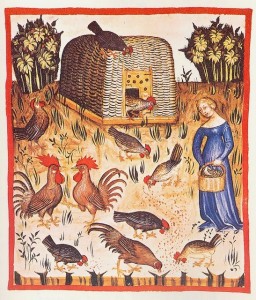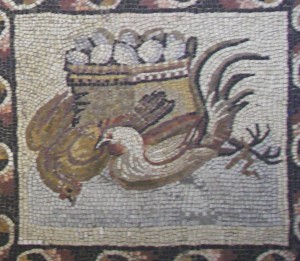Chickens in Historical Writings
This is a guest blog by undergraduate placement student Nicola Batley.
Other than from archaeological remains, we can find out about human interactions with chickens from historical texts. This provides us with unique insight about how people treated and felt about chickens – something that isn’t in their bones!
From reading various Roman texts (Columella and Apicius) you get to see both sides of the chicken, the animal side and the more familiar delicious side. Columella tells us about the practice of keeping chickens, from the most desirable breeds to medical care. This enables us to relate the most common and favoured breeds with assemblages of bones, so then we can possibly identify said breeds in future archaeological contexts. It can also help us understand any pathology on the bones as Columella mentions various conditions, such as gout and the pip. He also describes where to position chicken coops and, in immense detail, how they should be designed. Since chicken coops are unlikely to survive archaeologically, this proves very useful.

There is, naturally, the cooked side of chicken. There can be found, in both Roman and also Medieval texts, a variety of both disgusting and appealing recipes. Recipes are useful to us as they can suggest to us the degree to which chickens were exploited for food items (based on the frequency and number of recipes) as well as what chicken products were used more; such as hens, chicks, capons, rooster, breast/wings/thighs or whole chicken. This can be important in understanding the age/sex ratios in assemblages as well as the interpretation of the butchery marks apparent on the bones.
It is clear that historical texts are definitely a boon to the project, adding information otherwise unknown and aiding the understanding of archaeological bone assemblages.

Follow us
Keep up to date with the latest project news via our Twitter feed.
- — 5 years 8 months ago
- — 6 years 5 months ago
- — 6 years 7 months ago
- — 6 years 7 months ago

 ChickenCoop
ChickenCoop